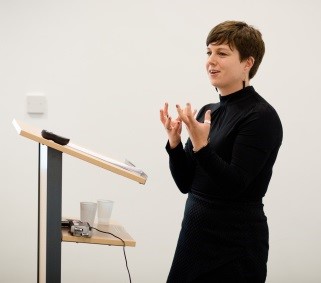
Dr Liz Sage
By Dr Liz Sage (FHEA)
Teaching Fellow in Teaching, Learning and Assessment in Higher Education
Department of Education
University of Sussex
During the ten years I’ve been teaching at Sussex, I’ve taught in some pretty varied contexts. Freshly-built lecture theatres and porta-cabin classrooms that tremble as people walk past. Seminar rooms full of light and up-to-date AV equipment and rooms where the projector screen comes down across the only whiteboard in the room. Rooms where I’ve had space to be inventive and spaces where the number of students we can accommodate according to the room listings has been ambitious to say the least.
The most extreme contrasts I’ve encountered have been in my time teaching new lecturers and staff on Sussex’s Postgraduate Certificate in Higher Education. The course is not included in the University’s formal timetabling and room allocation system, so we regularly end up teaching the same group in a host of different rooms, often asking our participants to visit parts of the campus they’ve never seen before – and moreover, asking the same group of people to move from an ideal teaching and learning space into something of a ramshackle fit for the kind of work we do in our PGCertHE sessions.
As a tutor, it’s been a challenge – trying to introduce staff to SMARTboard technology in a room without a SMARTboard for instance – but as a researcher in learning and teaching, it’s been incredible observing the impact that the movement between different learning environments has on individual learner’s behaviour and on the success of various teaching and learning methods.
For instance, with one group I worked with over five workshops, our first two session were in a large seminar room that allowed us to arrange the tables into clusters comfortably, with the AV equipment and whiteboard running along the long edge of a rectangular room, meaning everyone was only a few metres from the front of the room and I could move freely around the space. In both these sessions, the discussion was focused, the energy was productive and the participants engaged – I had a great group!
The next two sessions, it was like teaching a different group of people. People were whispering and carrying on conversations. The discussions were straying off into unrelated worries about work. Questions to the room fell flat and there were a lot more phones present on tables and in people’s hands. What had changed?
We were in a different room. This room was only just large enough for our numbers and we couldn’t really separate into the clusters for small group work I ideally use in these sessions. There were no windows, meaning the class was not only crowded but dark. And the AV set-up was along the narrowest wall of the rectangular room, meaning now we had people sitting ‘at the back’.
I felt the shift in attitude before I’d even begun. And having taught this session to many groups over the years, I knew the struggle to focus wasn’t a hallmark of this material and teaching activities. This group-wide shift seemed intimately connected to the space we were in. The very same learners who had been actively engaged in previous sessions were now struggling to focus, fighting the dark and heat of this small space and the people at the back of this long, narrow room were now behaving like the stereotypical student ‘at the back.’
To underline this, in our final session, we moved back into our initial seminar room and the learners I’d originally encountered were back – bright-eyed, engaged and keen to participate. For me, this was highlighted even further because the group of learners I was working with are colleagues, lecturers in their own right, who regularly face the same challenges as I do around getting learners engaged in different learning contexts. This is just one example – deliberately avoiding naming and shaming the spaces involved! – but time and again, I’ve witnessed the space I’m working in transforming a learner’s ability to participate and actively learn in a session.
I now explicitly reflect on the space in which we’re working at the start of any session – PGCertHE or otherwise – in order to help us all situate ourselves in relation to one another and to collectively recognise and address as far as we can any potential barriers created by a space, be they clear impediments or intangible cues in the environment that suggest to students that they should be passive when my teaching methods are asking them to be active and productive. This moment of critical reflection is not the solution – teaching spaces designed by pedagogical experts and centred around learners is an intriguing area of development in the HE sector – but I’ve been impressed with the difference acknowledging the shared teaching and learning space can have in getting everyone on board and ready to learn, wherever we are.


Leave a Reply